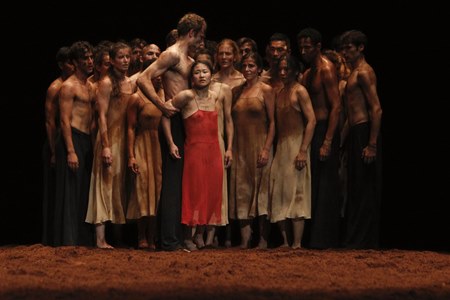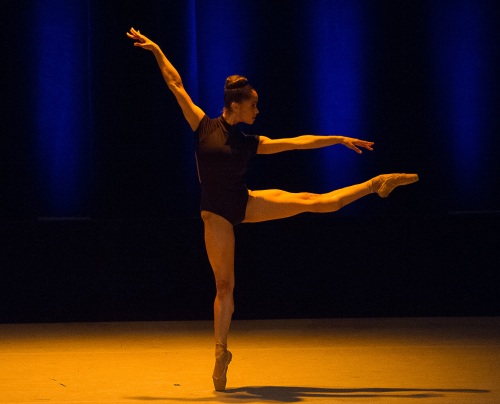Baila Blog, Ballet, Contemporary, Ballet, Contemporary Dance, Interviews, Dancer, Dance
Dance and the approach of “emotional interpretation”
Dance and the approach of “emotional interpretation”
In a shiny but dirty dress, protected and exposed at the same time, the “chosen one” emerges dancing a wild dance, surrounded by the community, until, inevitably, she succumbs to death. The dance in this solo, part of the legendary Rite of Spring her Pina Bausch, is one of the most “vulnerable” in the history of modern dance. “When I perform this role, there is no energy, my struggle is real, it becomes spiritual.”, says the dancer of the Wuppertal Dance Theater, Tsai-Wei Tien. “I squeeze everything I have into these final moments“.  A truly free-flowing, unguided approach electrifies the stage and connects deeply with the audience in a way that transcends even the most impeccable technical ability.“Often what separates a great dancer from a good dancer is the ability to reach that vulnerable point.", says the Dr. Nadine Kaslow, psychologist who collaborates with the Atlanta Ballet. “The truth is that it's hard for anyone to achieve it, dancer or not..”Perfectionism, self-doubt, anxiety, and tough defenses are all well-known “mental roadblocks.” But working to address and overcome them can help dancers let themselves go on stage, unlocking more dynamic performances.What exactly is a stage show?The term “vulnerability” is defined as susceptibility to physical or emotional harm and comes from the Latin word vulnus, meaning wound. People are generally most vulnerable when they have complete trust in someone else, so reaching that point in front of thousands of strangers takes real skill and courage.For the Samantha Speis, deputy artistic director and dancer in the company Urban Bush Women, artistic exhibition to the public is like “a deep dive” allowing the artist to be in a holistic state where all physical and mental molecules are available receptively to the present.”When I am at this point", he says, “"There are endless possibilities for what I express – my lineage, history, experiences, my narrative are all within the work.".The Challenges
A truly free-flowing, unguided approach electrifies the stage and connects deeply with the audience in a way that transcends even the most impeccable technical ability.“Often what separates a great dancer from a good dancer is the ability to reach that vulnerable point.", says the Dr. Nadine Kaslow, psychologist who collaborates with the Atlanta Ballet. “The truth is that it's hard for anyone to achieve it, dancer or not..”Perfectionism, self-doubt, anxiety, and tough defenses are all well-known “mental roadblocks.” But working to address and overcome them can help dancers let themselves go on stage, unlocking more dynamic performances.What exactly is a stage show?The term “vulnerability” is defined as susceptibility to physical or emotional harm and comes from the Latin word vulnus, meaning wound. People are generally most vulnerable when they have complete trust in someone else, so reaching that point in front of thousands of strangers takes real skill and courage.For the Samantha Speis, deputy artistic director and dancer in the company Urban Bush Women, artistic exhibition to the public is like “a deep dive” allowing the artist to be in a holistic state where all physical and mental molecules are available receptively to the present.”When I am at this point", he says, “"There are endless possibilities for what I express – my lineage, history, experiences, my narrative are all within the work.".The Challenges
 A truly free-flowing, unguided approach electrifies the stage and connects deeply with the audience in a way that transcends even the most impeccable technical ability.“Often what separates a great dancer from a good dancer is the ability to reach that vulnerable point.", says the Dr. Nadine Kaslow, psychologist who collaborates with the Atlanta Ballet. “The truth is that it's hard for anyone to achieve it, dancer or not..”Perfectionism, self-doubt, anxiety, and tough defenses are all well-known “mental roadblocks.” But working to address and overcome them can help dancers let themselves go on stage, unlocking more dynamic performances.What exactly is a stage show?The term “vulnerability” is defined as susceptibility to physical or emotional harm and comes from the Latin word vulnus, meaning wound. People are generally most vulnerable when they have complete trust in someone else, so reaching that point in front of thousands of strangers takes real skill and courage.For the Samantha Speis, deputy artistic director and dancer in the company Urban Bush Women, artistic exhibition to the public is like “a deep dive” allowing the artist to be in a holistic state where all physical and mental molecules are available receptively to the present.”When I am at this point", he says, “"There are endless possibilities for what I express – my lineage, history, experiences, my narrative are all within the work.".The Challenges
A truly free-flowing, unguided approach electrifies the stage and connects deeply with the audience in a way that transcends even the most impeccable technical ability.“Often what separates a great dancer from a good dancer is the ability to reach that vulnerable point.", says the Dr. Nadine Kaslow, psychologist who collaborates with the Atlanta Ballet. “The truth is that it's hard for anyone to achieve it, dancer or not..”Perfectionism, self-doubt, anxiety, and tough defenses are all well-known “mental roadblocks.” But working to address and overcome them can help dancers let themselves go on stage, unlocking more dynamic performances.What exactly is a stage show?The term “vulnerability” is defined as susceptibility to physical or emotional harm and comes from the Latin word vulnus, meaning wound. People are generally most vulnerable when they have complete trust in someone else, so reaching that point in front of thousands of strangers takes real skill and courage.For the Samantha Speis, deputy artistic director and dancer in the company Urban Bush Women, artistic exhibition to the public is like “a deep dive” allowing the artist to be in a holistic state where all physical and mental molecules are available receptively to the present.”When I am at this point", he says, “"There are endless possibilities for what I express – my lineage, history, experiences, my narrative are all within the work.".The Challenges
From her experience, Dr. Nadine Kaslow, both as a dancer and a dance psychologist, has found that rigorous training can be a barrier to an artist's exhibition. Too much of the training is about perfection, with the opposite orientation to artistic exhibition, with a sole focus on steps or technique, she says, and argues that more attention should be paid to the dancer as an individual. The Food She also notes that in our culture, vulnerability often equates with weakness. She had to break down these assumptions, she argues, in order to allow herself to be exposed on stage.
“Much of the training focuses on perfection, with a singular focus on steps or technique", he says. He has also found that the process of collaboration within the team Urban Bush Women, helps to cultivate the individual voices of the dancers. Instead of artists keeping ideas and emotions inside themselves, he recommends that they feed them into the work, e.g. experimenting with an idea, seeing what they feel and what triggers them, and sharing it.Finding vulnerability through authenticityAccording to Dance Magazine,before she dies, the Pina Bausch stated that "I want my dancers to be natural, to let what's inside them come out, to have a real presence"Her team continues to work on this philosophy to this day. The Tsai-Wei Tien argues that allowing the artist to experience the natural journey of the piece leads to an authentic experience, as if living real life: seeing, reacting, engaging and, ultimately, BEING.However, many dancers prefer traditional approaches to lead themselves into vulnerable situations on stage. Susan Batson, actress and mentor of the choreographer Francesca Harper, as well as many well-known actors, such as Nicole Kidman and the Juliette Binoche, says that great artists live their personal experiences consciously during the performance. “Some artists are good, but we don't feel them, we only observe them.", says Batson and goes on to urge artists: "Once you learn to communicate with yourself, be sure that you will be authentic on stage.“.OR Erina Takahashi, first dancer of English National Ballet, recently discovered the power of this process in creating the impressive Giselle of Akram KhanDuring the rehearsal, the Akram Khan gave her enough space to clarify who Giselle really is, what she feels and desires. “I had to find meaning in every step.”, says Takahashi. “After hours of exploratory rehearsal and introspection, a fully “vulnerable” Giselle could now be on stage without feeling the awkwardness of the stage. I was able to connect the pain, the joy, the upset, the disappointment and place them in this work.“.Suggestions from a psychologistFor dancers struggling with stage fright, psychologist Dr. Nadine Kaslow recommends the following:– Remember that there is no way to be perfect and that you cannot be perfect and vulnerable at the same time.
– Ask choreographers, teachers, and peers for feedback. Ask them to focus on the vulnerability of your performance.
– Take time to dance on your own. This freedom can reveal many things that will help you on stage.
– Read books on mindfulness and find time for self-observation. This awareness can prevent stress and keep you away from worry.
– If public exposure is an ongoing difficulty, repressed personal emotions may require attention: Many times growing up in a family where emotions were not expressed or expressed in an aggressive way, or dealing with trauma, can prevent a dancer from expressing their emotions on stage.
– Treatment is recommended if this issue interferes with an artist's goals and professional pursuits.
– Ask choreographers, teachers, and peers for feedback. Ask them to focus on the vulnerability of your performance.
– Take time to dance on your own. This freedom can reveal many things that will help you on stage.
– Read books on mindfulness and find time for self-observation. This awareness can prevent stress and keep you away from worry.
– If public exposure is an ongoing difficulty, repressed personal emotions may require attention: Many times growing up in a family where emotions were not expressed or expressed in an aggressive way, or dealing with trauma, can prevent a dancer from expressing their emotions on stage.
– Treatment is recommended if this issue interferes with an artist's goals and professional pursuits.
Sources: dancetheater.gr
Jen Peters, www.dancemagazine.com

